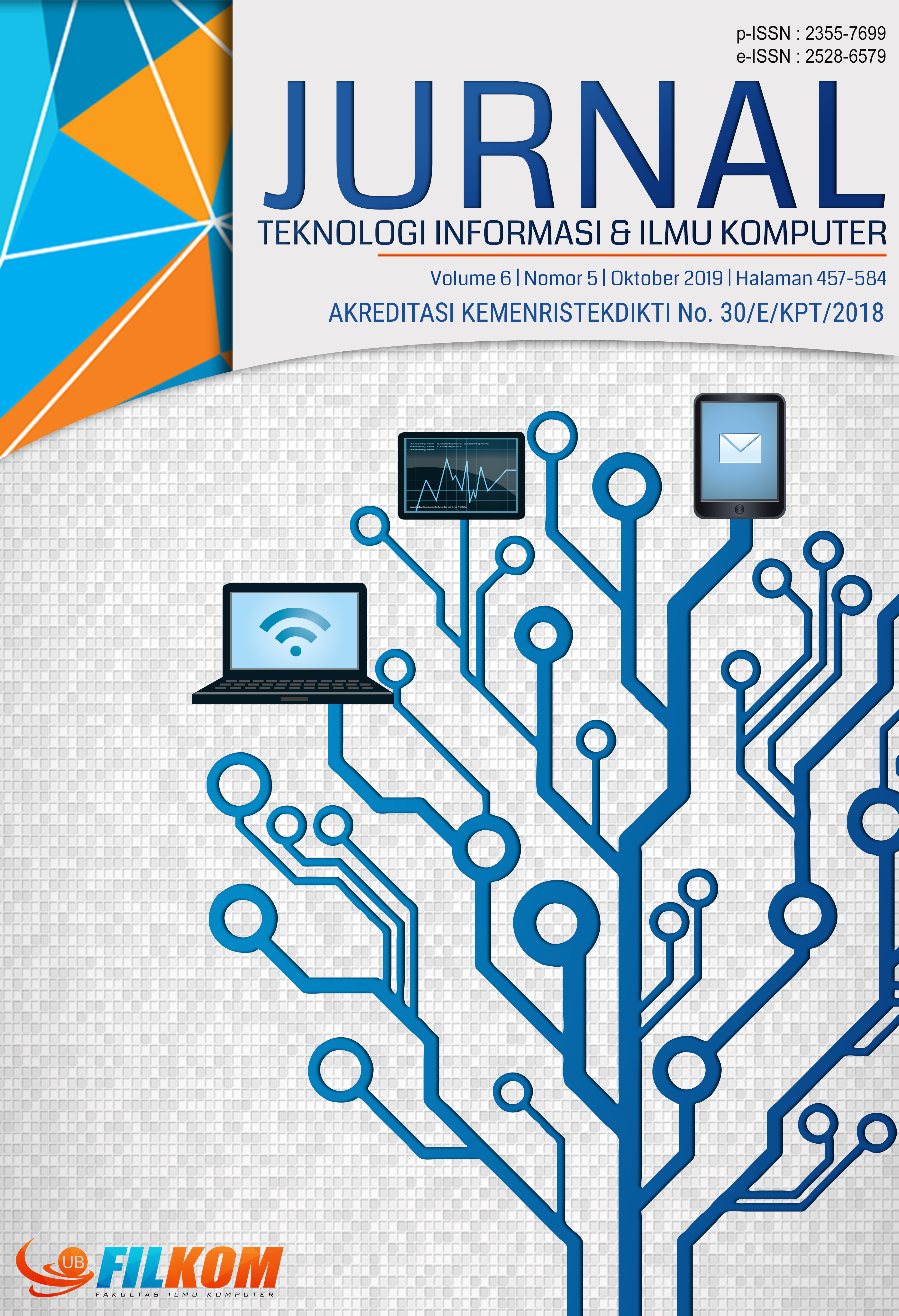Eksplorasi ABAC dan XACML untuk Design Access Control pada Resource Digital
DOI:
https://doi.org/10.25126/jtiik.2019651679Abstrak
Resource digital memerlukan sebuah mekanisme untuk mengatur policy terhadap kontrol untuk mendapatkan hak akes ke dalam suatu sistem. Akses kontrol lebih fleksibel dibanding dengan pendekatan otorisasi, autentikasi ataupun verifikasi yang sangat sederhana. Mekanisme access control policy dengan pendekatan atribut diyakini sebagai solusi adaptif yaitu ABAC (Attribute Based Access Control) dengan implementasi model XACML (Extensible Access Control Modelling Language). Desain policy ABAC ini disajikan dengan atribut-atribut dari salah satu studi kasus resource digital dengan sistem e-Library. e-Library merupakan salah satu resource digital dimana proses autentikasinya belum dimodelkan dengan atrubut subjek yang ada. Penelitian ini diawali dari identifikasi atribut dari rule, pemodelan ABAC resource digital, implementasi XACML, simulasi sistem dan analisis sistem. Hasil dari pengujian akses kontrol menggunakan ALFA (Axiomatics Language for Authorization) untuk pemberian kinerja akses kontrol terhadap resource digital. Hasil analisis dengan pendekatan ABAC dengan model XACML ini menyajikan suatu keamanan sistem dengan model akses kontrol berbasis atribut dari policy statement untuk menjadi solusi model akses kontrol yang dibuat sebelumnya dan mendukung model akses kontrol yang relevan untuk resource digital
Abstract
Digital resources require a mechanism to regulate policy against controls to get access rights to a system. Access control is more flexible than the very simple approach of authorization, authentication or verification. The access control policy with the attribute approach is believed to be an adaptive solution, namely ABAC (Attribute Based Access Control) with the implementation of the XACML (Extensible Access Control Modeling Language) model. This ABAC policy design is presented with attributes from one of the digital resource case studies with the e-Library system. e-Library is one of the digital resources where the authentication process has not been modeled with the existing subject matter. This study begins with the identification of the attributes of the rule, digital ABAC resource modeling, XACML implementation, system simulation and system analysis. The results of testing access control using ALFA (Axiomatics Language for Authorization) to provide performance control access to digital resources. The results of the analysis using the ABAC approach with the XACML model present a system security with attribute-based access control models from policy statements to be a solution to the previously created access control model and support the access control model relevant for digital resources
Downloads
Referensi
CAVOUKIAN, A .2015. The Importance of ABAC
Attribute-Based Access Control to Big Data : Privacy and Context.
D. FERRAIOLO, S. G. 2015. Policy Machine: Features, Architecture, and Specification. National Institute of Standards and Technology (NIST) IR-7987 Revision 1, 23-28.
HSU, C.-L. A.-L. 2011. A Digital Evidence Protection Method with Hierarchical Access Control Mechanisms. IEEE (hal. 1–9). Barcelona: IEEE International Carnahan Conference on Security Technology (ICCST).
HU, V. C. 2015. Attribute-Based Access Control.
Computer, doi:10.1109/MC.2015.33.
JIN, X. 2014. Attribute-Based Access Control Models and Implementation in Cloud Infrastructure as A Service . The University of Texas at San Antonio, doi:10.1007/s13398-014-0173-7.2.
KARP, A. H. 2009. [Online] From ABAC to ZBAC : The Evolution of Access Control Models From ABAC to ZBAC. The Evolution of Access Control Models, http://www.hpl.hp.com/techreports/2009/H PL-2009-30.pdf.
KURNIAWAN A, RIADI, I, & LUTHFI, A. 2017. Forensic Analysis And Prevent Of Cross Site Scripting In Single Victim Attack Using Open Web Application Security Project (OWASP) Framework. Journal of Theoretical and Applied Information Technology, 1363-1371
PANENDE,M.F, PRAYUDI,Y, & RIADI, I . 2018. Konsep Attribute Based Access Control (ABAC) Pada Lemari Penyimpanan Bukti Digital (LPBD). Jurnal Teknik Informatika Vol. 11 No. 1, 85-94
RIADI, I, SUNARDI, & FIRDONSYAH, A. 2017. Forensic Investigation Technique on Android’s Blackberry Messenger using NIST Framework. International Journal of Cyber-Security and Digital Forensics (IJCSDF), 198-205
RIADI, I, UMAR R, & NASRULLOH I M, 2018. Experimental Investigation of Frozen Solid State Drive on Digital Evidence with Static Forensic Methods. Lontar Komputer, 169-181
SANDHU, R. 2010. Security Models : Past , Present and Future San Antonio, TX, USA. Institute for Cyber Security, UTSA USA. , http://profsandhu.com/miscppt/utsa100831. pdf.
STALLINGS, W. A. (2015). Computer Security : Principles and Practice. 3rd Editio. USA: Pearson Education International.
SUBEKTINGSIH, PRAYUDI,Y, & RIADI, I. 2018. Digital Forensics Workflow as A Mapping Model for People, Evidence, and Process in Digital Investigation. Journal of Cyber-Security and Digital Forensics, 294-304
TAYLOR, C. B.-P. 2007. Specifying Digital Forensics: A Forensics Policy Approach. Digital Investigation 4 (September), 101–104. doi:10.1016/j.diin.2007.06.006.
VARADHARAJAN, V. 2015. Policy Based Role Centric Attribute Based Access Control Model Policy RC-ABAC. Conference on Computing and Network Communications (CoCoNet'15), 12-17.
XU, D. A. 2014. Specification and Analysis of Attribute-Based Access Control Policies: An Overview. Proceedings - 8th International Conference on Software Security and Reliability - Companion SERE- 2014, 41–49. doi:10.1109/SERE.
Unduhan
Diterbitkan
Terbitan
Bagian
Lisensi

Artikel ini berlisensi Creative Common Attribution-ShareAlike 4.0 International (CC BY-SA 4.0)
Penulis yang menerbitkan di jurnal ini menyetujui ketentuan berikut:
- Penulis menyimpan hak cipta dan memberikan jurnal hak penerbitan pertama naskah secara simultan dengan lisensi di bawah Creative Common Attribution-ShareAlike 4.0 International (CC BY-SA 4.0) yang mengizinkan orang lain untuk berbagi pekerjaan dengan sebuah pernyataan kepenulisan pekerjaan dan penerbitan awal di jurnal ini.
- Penulis bisa memasukkan ke dalam penyusunan kontraktual tambahan terpisah untuk distribusi non ekslusif versi kaya terbitan jurnal (contoh: mempostingnya ke repositori institusional atau menerbitkannya dalam sebuah buku), dengan pengakuan penerbitan awalnya di jurnal ini.
- Penulis diizinkan dan didorong untuk mem-posting karya mereka online (contoh: di repositori institusional atau di website mereka) sebelum dan selama proses penyerahan, karena dapat mengarahkan ke pertukaran produktif, seperti halnya sitiran yang lebih awal dan lebih hebat dari karya yang diterbitkan. (Lihat Efek Akses Terbuka).















